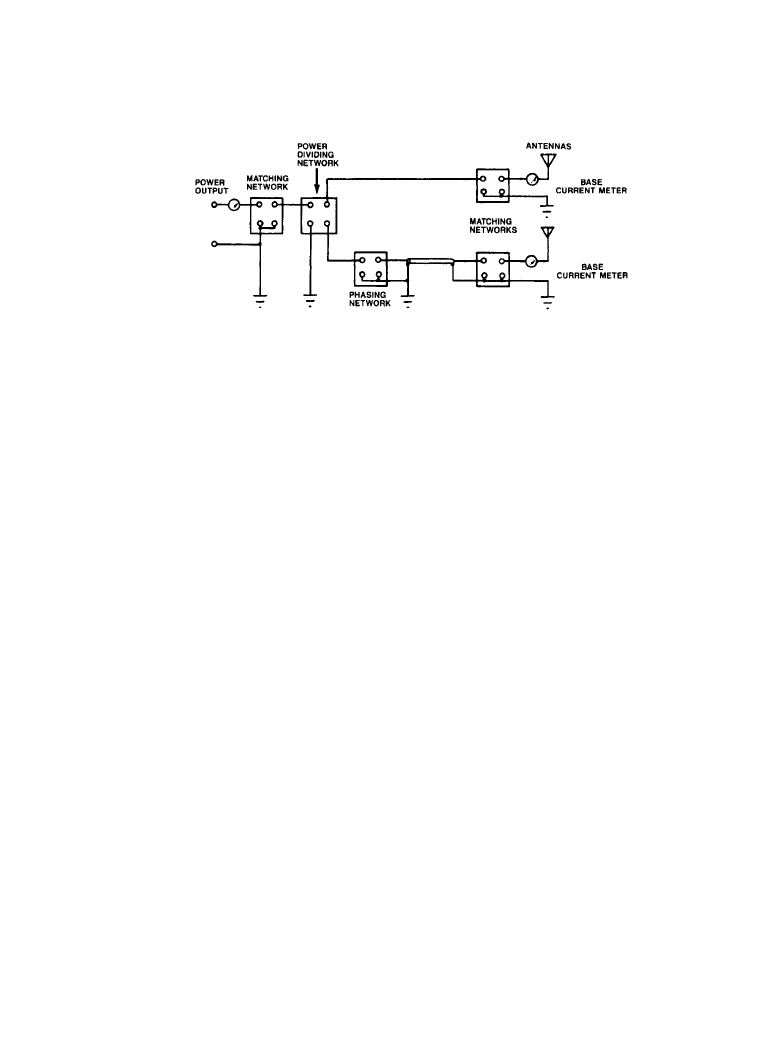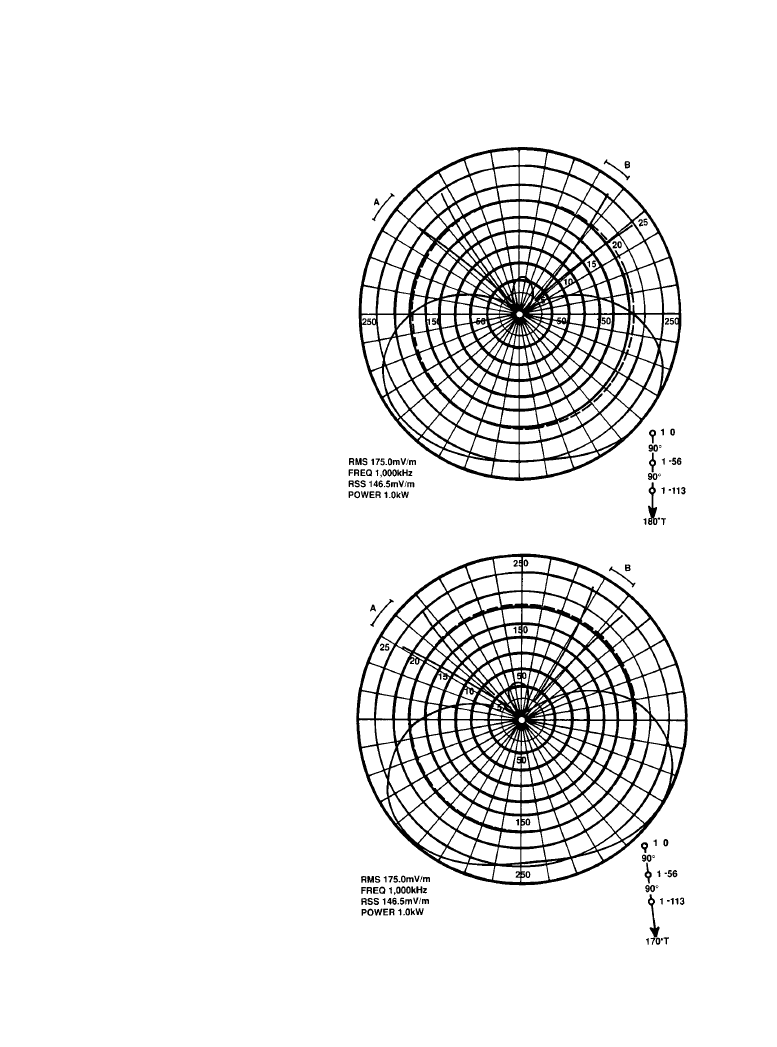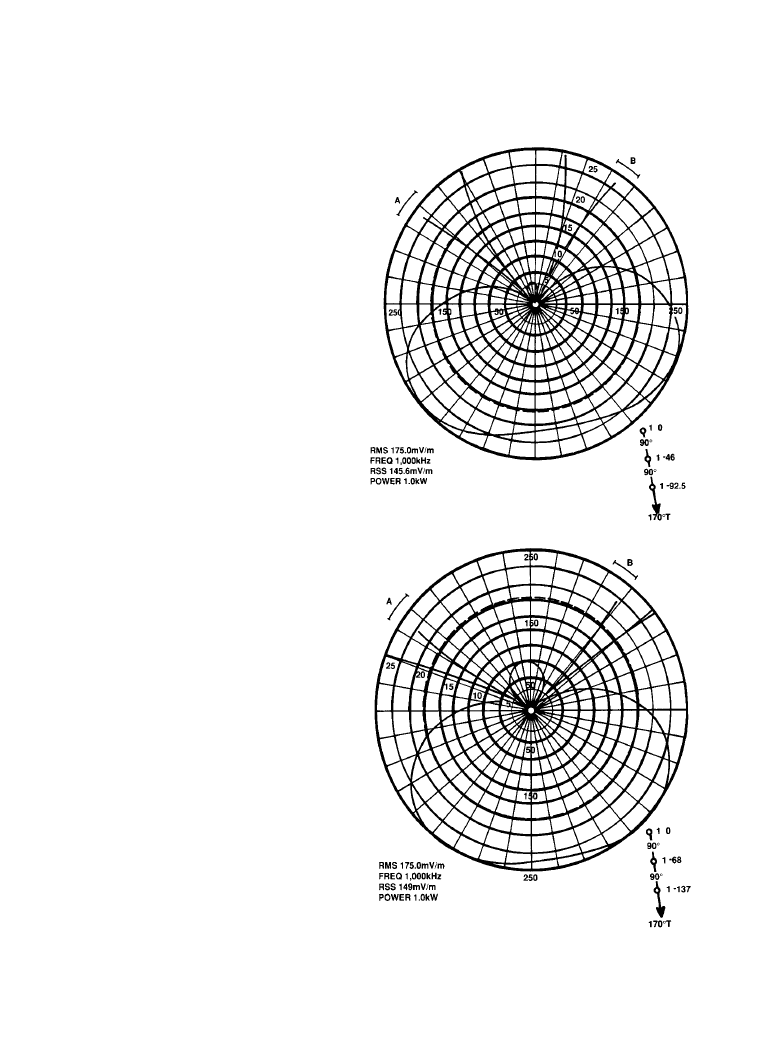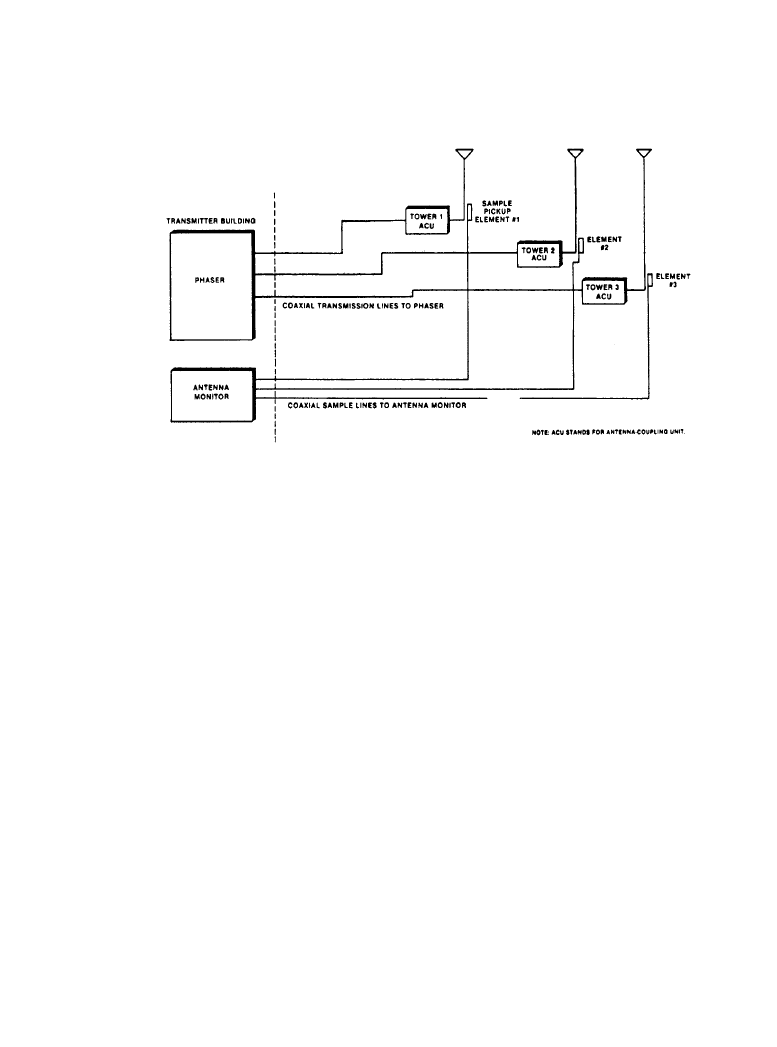ВУЗ: Казахская Национальная Академия Искусств им. Т. Жургенова
Категория: Книга
Дисциплина: Не указана
Добавлен: 03.02.2019
Просмотров: 21645
Скачиваний: 19

Transmitting Antennas 11-117
complex system. One tower is defined as the reference tower. The amplitude and phase of the
other towers are measured relative to this reference.
A complex network of power splitting, phasing, and antenna coupling elements is required to
make a directional system work. Figure 11.5.13 shows a block diagram of a basic two tower
array. A power divider network controls the relative current amplitude in each tower. A phasing
network provides control of the phase of each tower current, relative to the reference tower.
Matching networks at the base of each tower couple the transmission line impedance to the base
operating impedance of the radiating towers.
In practice, the system shown in the figure would not consist of individual elements. Instead,
the matching network, power dividing network, and phasing network are usually combined into a
single unit, referred to as the phasor.
Antenna Pattern Design
The pattern of any AM directional antenna system (array) is determined by a number of factors,
including:
•
Electrical parameters (phase relationship and current ratio for each tower)
•
Height of each tower
•
Position of each tower with respect to the other towers (particularly with respect to the refer-
ence tower)
A directional array consists of two or more towers arranged in a specific manner on a plot of
land. Figure 11.5.14 shows a typical 3-tower array, and the pattern such an array would produce.
This is an in-line array, meaning that all the elements (towers) are in line with one another.
Notice that the major lobe is centered on the same line as the line of towers, and that the pattern
nulls (minima) are positioned symmetrically about the line of towers, protecting co-channel sta-
tions A and B at true bearings of 315° and 45°, respectively.
Figure 11.5.15 shows the same array, except that it has been rotated by 10°. Notice that the
pattern shape is not changed, but the position of the major lobe and the nulls follow the line of
towers. Also notice that the nulls no longer are pointed at the stations to be protected. Figures
11.5.16 and 11.5.17 show that the position of the nulls can be changed by varying the electrical
Figure 11.5.13
Block diagram of an AM directional antenna feeder system for a two tower array.
Downloaded from Digital Engineering Library @ McGraw-Hill (www.digitalengineeringlibrary.com)
Copyright © 2004 The McGraw-Hill Companies. All rights reserved.
Any use is subject to the Terms of Use as given at the website.
Transmitting Antennas

11-118 Broadcast Transmission Systems
Figure 11.5.14
Radiation pat-
tern generated with a 3-tower
in-line directional array using
the electrical parameters and
orientation shown.
Figure 11.5.15
Radiation pat-
tern produced when the array of
Figure 11.5.14 is rotated to a
new orientation.
Downloaded from Digital Engineering Library @ McGraw-Hill (www.digitalengineeringlibrary.com)
Copyright © 2004 The McGraw-Hill Companies. All rights reserved.
Any use is subject to the Terms of Use as given at the website.
Transmitting Antennas

Transmitting Antennas 11-119
Figure 11.5.16
Directional pattern
generated with the orientation
shown in Figure 11.5.15, but with
different electrical parameters.
Figure 11.5.17
Directional pattern
generated by the tower orientation
shown in Figure 11.5.15, but with a
new set of electrical parameters.
Downloaded from Digital Engineering Library @ McGraw-Hill (www.digitalengineeringlibrary.com)
Copyright © 2004 The McGraw-Hill Companies. All rights reserved.
Any use is subject to the Terms of Use as given at the website.
Transmitting Antennas

11-120 Broadcast Transmission Systems
parameters so that one or the other can be pointed in the required direction, but not both. Also,
when this is attempted, the size and shape of the small back lobe is changed, as is the shape of the
major lobe, especially the radiation on the line of towers.
If this directional antenna system were constructed on a gigantic turntable, the pattern could
be rotated without affecting the shape. But, to accomplish the required protections and to have
the major lobe(s) oriented in the right direction, there is only one correct position. In most cases,
the position of the towers will be specified with respect to a single reference tower. The location
of the other towers will be given in the form of a distance and bearing from that reference. Occa-
sionally, a reference point, usually the center of the array, will be used for a geographic coordi-
nate point.
11.5.4b
Bearing
The bearing or azimuth of the towers from the reference tower or point is specified clockwise in
degrees from true north. The distinction between true and magnetic north is vital. The magnetic
North Pole is not at the true or geographic North Pole. (In fact, it is in the vicinity of 74° north,
101° west, in the islands of northern Canada.) The difference between magnetic and true bear-
ings is called variation or magnetic declination. Declination, a term generally used by surveyors,
varies for different locations; it is not a constant. The earth's magnetic field is subject to a num-
ber of changes in intensity and direction. These changes take place over daily, yearly, and long-
term (or secular) periods. The secular changes result in a relatively constant increase or decrease
in declination over a period of many years.
Antenna Monitoring System
Monitoring the operation of an AM directional antenna basically involves measuring the power
into the system, the relative value of currents into the towers, their phase relationships, and the
levels of radiated signal at certain monitoring points some distance from the antenna. Figure
11.5.18 shows a block diagram of a typical monitoring system for a three tower array. For sys-
tems with additional towers, the basic layout is extended by adding more pickup elements, sam-
ple lines, and a monitor with additional inputs.
Phase/Current Sample Loop
Two types of phase/current sample pickup elements are commonly used: the sample loop and
torroidal current transformer (TCT). The sample loop consists of a single turn unshielded loop
of rigid construction, with a fixed gap at the open end for connection of the sample line. The
device must be mounted on the tower near the point of maximum current. The loop can be used
on towers of both uniform and non-uniform cross section. It must operate at tower potential,
except for towers of less than 130° electrical height, where the loop can be operated at ground
potential.
When the sample loop is operated at tower potential, the coax from the loop to the base of the
tower is also at tower potential. In order to bring the sample line across the base of the tower, a
sample line isolation coil is used.
A shielded torroidal current transformer can also be used as the phase/current pickup ele-
ment. Such devices offer several advantages over the sample loop including greater stability and
Downloaded from Digital Engineering Library @ McGraw-Hill (www.digitalengineeringlibrary.com)
Copyright © 2004 The McGraw-Hill Companies. All rights reserved.
Any use is subject to the Terms of Use as given at the website.
Transmitting Antennas

Transmitting Antennas 11-121
reliability. Because they are located inside the tuning unit cabinet or house, TCTs are protected
from wind, rain, ice, and vandalism.
Unlike the rigid, fixed sample loop, torroidal current transformers are available in several sen-
sitivities, ranging from 0.25–1.0 V per ampere of tower current. Tower currents of up to 40 A or
more can be handled, providing a more usable range of voltages for the antenna monitor.
Figure 11.5.19 shows the various arrangements that can be used for phase/current sample
pickup elements.
Sample lines
The selection and installation of the sampling lines for a directional monitoring system are
important factors in the ultimate accuracy of the overall array.
With critical arrays (antennas requiring operation within tight limits specified in the station
license) all sample lines must be of equal electrical length and installed in such a manner that
corresponding lengths of all lines are exposed to equal environmental conditions.
While sample lines can be run above ground on supports (if protected and properly grounded)
the most desirable arrangement is direct burial using jacketed cable. Burial of sample line cable
is almost a standard practice because proper burial offers good protection against physical dam-
age and a more stable temperature environment.
The Common Point
The power input to a directional antenna is measured at the phasor common point. Power is deter-
mined by the direct method
Figure 11.5.18
A typical 3-tower directional antenna monitoring system.
Downloaded from Digital Engineering Library @ McGraw-Hill (www.digitalengineeringlibrary.com)
Copyright © 2004 The McGraw-Hill Companies. All rights reserved.
Any use is subject to the Terms of Use as given at the website.
Transmitting Antennas